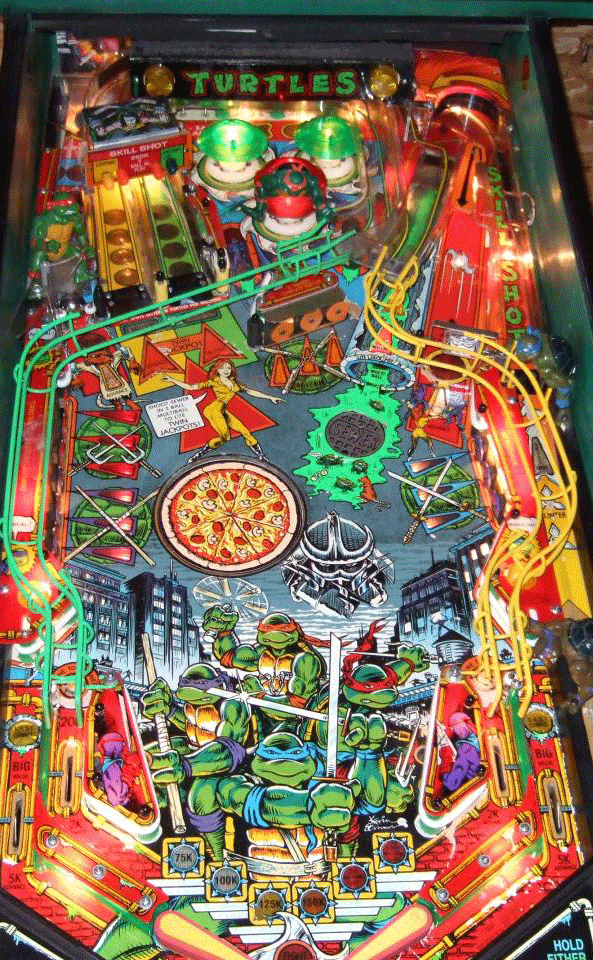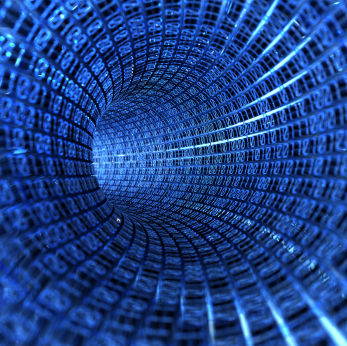
The evolution and decline of pinball
What is it about pinball? The bastard child of Yankee ingenuity and pop-cult razzle-dazzle, pinball manages to be at once seedy and silly. And it’s fun – the perfect expression of 20th-century America’s technological quest for trivial distraction. Not quite a sport but more than a game, pinball is perhaps best seen as a media machine. It unveils a kinetic cosmos under glass, a comic-book world of collisions and speed that draws us in even as it remains forever out of reach.
But over the last half-dozen years, pinball has been skating on thin ice, its time-tested techniques for extracting quarters from pockets increasingly challenged by the commanding might of videogames. And now the ice has cracked. Toll the bell: Pinball, a cultural technology that has swallowed our coins since the Great Depression, is dead.
After a last-ditch attempt to revive a moribund market, WMS Industries – the Microsoft of pinball – built its last game in November. Not that WMS has hit the skids. The $375 million Chicago-based company is riding high on slot machines and video-lottery gear, and its stock price practically doubled in 1999. But the pinball division has lost a total of $17.8 million over the last three fiscal years. As far as the bean counters were concerned, pinball was a loser’s game – so much so that when Wall Street heard WMS had ditched a 50-year commitment to America’s greatest arcade diversion, the company’s stock jumped another 6 percent.
The pinball industry has not completely collapsed. Stern Pinball – a small Melrose Park, Illinois, company recently let go by Sega – will continue to manufacture machines, fulfilling owner Gary Stern’s vow to be “the last man standing.” But Stern is nothing compared with the WMS colossus. In a poll published last year in the industry magazine RePlay, the WMS brands – which over the years have included Williams, Bally, and Midway – accounted for 9 of the 10 top-earning pinball machines in the US. For a pinball fan, the fact that Stern is still cranking them out is hardly comforting. It’s like hearing that even though Japan, Detroit, and Germany have stopped making cars, you can still drive a Yugo.
Pinball’s de facto demise reminds us that technology evolves until it reaches a cozy niche, like the ones forks or blue jeans occupy, or until it becomes extinct. In fact, the story of pinball is a great Darwinian epic, with human culture playing the part of the Galápagos Islands.
We view the human world through human eyes; to us, the history of technology looks like a history of our genius and invention. But though inventors often have great brains, you could view those brains as nothing more than the reproductive organs of machines, which have no way (yet) of making their own evolutionary moves. Machines redesign themselves through human beings.
Human culture exerts an overwhelming selection pressure on machine mutation. Most species of technology are governed by efficiency and utility and coevolve with the human desire to get stuff done. But pinball owes its existence solely to the pleasure it creates in human hands (and the quarters those hands feed to the machine). The game has no utilitarian value. Indeed, a pinball console is one of the most intricate machines that have evolved strictly for the amusement of man. As such, it has also become arguably the most colorful and bizarre species in the machine phylum – the platypus of technology.
Any discussion of evolution inevitably leads to the question of origin, one no less contested, in pinball’s case, than in that of whales or eyeballs. Roger Sharpe – pinball wizard, Midway licensing director, and author of Pinball! – argues convincingly that the first real ancestor of today’s game was a late-Victorian twist on billiards, which involved smacking balls into holes of different value, called Improvements in Bagatelles. Emerging from the primordial soup of Cincinnati in 1871, the game had a striking feature: a spring-loaded plunger that launched the ball into play.
After improvements in Bagatelles, the developing machine did not get a real boost up the evolutionary ladder until the eve of the Great Depression, when Chicago parts supplier Leo Berman cobbled together a version that included an inclined plane, an improved plunger, and hedges of brass pins surrounding the scoring holes. News of the machine traveled through the world of coin-op manufacturers. In less than two years, Gottlieb’s Baffle Ball and Bally’s Ballyhoo crawled out of the sea of possibilities and strode onto land.
These machines looked no more like modern pinball games than Australopithecus africanus looks like your mom. They were small and light, devoid of flippers, sounds, and the upright back-glass at the top of the machine. Gameplay depended largely on chance; the action was more like the Japanese gambling game of pachinko. But in the low-income chaos of the early Depression, Baffle Ball and Ballyhoo became monster hits. At a penny or a nickel a shot, the Chicago-bred games offered cheap thrills for the masses.
Players of the flipperless game did not always watch helplessly as the steelie bumped toward the target holes – they’d bump and shake the table. To put a damper on this, Stanford engineering grad Harry Williams, who would later found the WMS pinball empire, came up with the tilt mechanism in 1932. When the tilt was tripped, the machine would die in the midst of battle, or at least hibernate, frustrating and teasing the player with serious pinballus interruptus. Williams also started to feed his games electricity, and in his 1933 game Contact, the solenoid appeared: an electromagnetic coil outfitted with a kicker that could give the ball that now-familiar punch up the playfield.
Darwinian struggles between game companies drove pinball innovation throughout the 1930s, a decade that saw the emergence of revolving discs, ball traps, bumpers, and the back-glass. But the most important development would have to wait until after World War II. A Gottlieb engineer named Harry Mabs was mucking around in the shop when he suddenly realized that one could modify the bat-swinging mechanism from an arcade baseball game and splice it into pinball. This cross-pollination led to the flipper, the opposable thumb of the game. First appearing in 1947’s Humpty Dumpty machine, the device spread through the industry within a year. According to Sharpe, “The flipper literally became an extension of your fingertips. It was like you could reach under the glass and influence the ball.”
***
The flipper attracted lots of new pinball fans in the 1950s and ’60s, including many men and boys serious enough to push the machine to its limits. Then, as now, committed players often approached the machine with an air of competitive aggression, riding the flippers like gunslingers and trying to beat the game. But when they’re in the zone, great players – “wizards” – merge with the machine. Aggression gives way to eroticism, to a cyborg dance with the mechanical bride.
“I used to believe that pinball was the ultimate test of man versus machine,” says Sharpe. “But over the years, I have come to the realization that in some ways the machine is a living, breathing soul. There needs to be an organic relationship there, a feeling of oneness. You are almost caressing the machine in order to maximize it.”
From the point of view of pinball itself, there was a great Darwinian motive for pleasuring humans while continuing to compete with them: It kept ’em coming back. The late industry heavyweight Herb Jones, author of the technological survey Coin-Operated Amusement, called it the “come close, try again” effect, and he argued that any pinball machine that wanted to survive needed it. By giving good play over time, a machine ensured that its brethren would continue to multiply back at the plant. Moreover, individual mutations – like multiball or peculiar scoring targets – also had a chance of replicating themselves in future generations of games.
Successful pinball games were good at seduction. One of the earliest, a 1930s game called Pla-Girl, was advertised as “The Only Pin Game With Sex Appeal!!” In the postwar era, pinball games took a tip from butterflies and peacocks and started reeling players in with colorful and entrancing visual come-ons: starships, sports heroes, jesters, and lots of babes with volleyball breasts. With these comic-book fantasies and the serious electromechanical fun available beneath the glass, pinball ruled the arcade like dinosaurs ruled the Cretaceous. That is, until the asteroid.
Asteroids, to be exact. And Pong. And Centipede, and the other superstars of videogames’ golden age, which lasted from the mid-’70s to the mid-’80s. The computerized arcade game was pinball’s first genuinely fierce competitor. Stealing a page from the rival’s playbook, pinball games like Dyn O’ Mite incorporated solid-state components as early as 1976. In the 1980s, integrated circuits gave pinball a videogame beat, boosting scoring memory and creating alphanumeric displays, a complex plotline of targets, and a vastly expanded soundtrack of theme music, explosions, and voices.
By the late 1980s, there was a videogame backlash, and pinball was on a roll again, having hybridized old-school flipper action with the emerging world of electronic entertainment. But the writing was on the wall. In 1993, its peak year in the 1990s, WMS estimated the world pinball market to be around 100,000 units; five years later, it cratered to only 15,000 machines. WMS surveyed pinball distributors and owners and came away with a load of complaints. The mechanical parts broke too easily. Simple problems, like a stuck ball or dirty flipper, would keep machines dark for days until a technician showed up to doctor it. Pinball machines were too heavy, bulky, and delicate compared with videogames. The arcade dinosaur had met its mammal.
The evolution of technology proceeds most quickly when the selection pressures are most intense. In mid-1998, after two years of operating losses, the pinball division at WMS was put on notice. “We knew that if we didn’t come up with something,” says Pat Lawlor, a senior game designer at the company, “they were going to yank the plug.”
What Lawlor, fellow game designer George Gomez, and their colleagues came up with was Revenge From Mars – the first pinball game built, like a videogame, around a CPU. Revenge replaces real targets with holograms, which respond to the steel ball as it zooms by. Careening up the wooden playfield, the ball can blast a flying saucer hovering above the Eiffel Tower, savage the evil Big-O-Beam, and launch missiles against aliens in a homage to Space Invaders.
Revenge was the first game in a whole new species of pinball – a “game platform” dubbed Pinball 2000. Responding to operators’ complaints, the system offered advanced “self-healing” features and was easy to maintain. If the game broke, the owner could remove the entire playfield, insert a replacement, and send the damaged one back. The servers at the WMS mother ship could then feed the machine a completely new game program via a built-in modem. Interchangeable decals made it possible to convert the cabinet as well.
Pinball 2000 drew some industry buzz, and many players found the game amusing when it appeared in January 1999 – but by the end of the year there was simply not enough coin in the cash box to justify another product cycle. Though some players grumbled that WMS gave up without a fight, the second Pinball 2000 title to ship, Star Wars: Episode I, was also the last.
In the 1970s, solid-state electronics allowed pinball to survive and even prosper. But today’s powerful microprocessors have carved a new cultural landscape. The more we go digital, the less of a foothold pinball has, because the game is still sunk waist-deep in the old electromechanical biome.
“Pinball is in between the industrial revolution and the information age,” says Pat Blashill, a New York writer and self-described “professional pinball obsessive.” Nowadays, computer games have more survival value than pinball because computers have seduced new generations of human nervous systems into a different kind of gamespace: virtuality. “Pinball is a warm entertainment,” Blashill elaborates. “It’s electronic, but it’s still wood and metal. It’s still about using the heel of your hand to knock a big, giant machine so that Martians can die. Videogames aren’t about physical interaction; they’re about information interaction.”
In essence, the preferred playspace is no longer physical space at all, but the increasingly immersive digital space. Ironically, it was pinball that first seduced us into exploring a world behind glass, a world we could touch only by fusing our fingers with control devices. In retrospect, pinball was only a bridge between the machine age and the digital age. Like it or not, we have reached the farther shore.
Even those most committed to pinball’s survival understand neobiology’s cruel ways. Just days before WMS pulled the plug, Pat Lawlor, the co-creator of Pinball 2000, stoically bowed before fate. “If people are unwilling or unable to put money in our games, then we shouldn’t be here,” he said. “We’re a buggy whip, and we should go away.”




